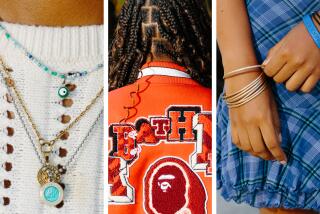Ways to Pass the Shopping-for-the-Kids Test
- Share via
What’s a parent to do?
Your 14-year-old daughter insists on buying a leather bustier and micro-miniskirt for her fall back-to-school wardrobe. Your 8-year-old boy whines loudly for the highest-price athletic shoes in the store. Your hungry, bored preschooler throws a screaming fit, slips out of the dressing room, jumps on the down escalator and is retrieved by store security guards.
For some families, back-to-school shopping turns into a costly battle of wills, as parents and children go head-to-head over clothing styles and price tags.
But child-development experts, educators and parents say shopping for children doesn’t have to be unpleasant. By planning ahead, setting clear limits and talking with your children before you head for the malls, fall shopping sprees can go smoothly.
Giving children some sense of responsibility over how to spend money and choose clothes, within certain limits, is important, says Dr. Jean Holroyd, clinical psychologist at UCLA and the mother of three grown sons.
“At a very early age--12 or 13--children can be given a clothing allowance. They need to learn how to wisely buy their clothes and then live with their successes or their mistakes. Don’t let them exceed the (dollar) limit,” Holroyd says.
One way for parents to avoid battles in the store over what a child wants is to set a budget and discuss what you’re shopping for before you leave home. That’s a good way to prevent being pressured into buying things your children don’t need or you can’t afford.
Linda Pierog of San Juan Capistrano says she and her daughters, Margaux, 11, and Jessica, 13, make out a budget and list of clothing each needs.
“We look at Seventeen magazine to see what styles they like and discuss what will be best for them,” she says.
Then when they shop, the girls are allowed to choose their clothes as long as they stay within the budget. If they want additional items, they can earn the money by baby-sitting or walking dogs, says Pierog, who is an executive director of case management at St. Jude Medical Center in Fullerton.
Holroyd says parents shouldn’t get too concerned over styles their children choose. But if the youngsters want clothing that the parent believes is too revealing or inappropriate, explain to them what the implications are of wearing such things to school and be firm, Holroyd advises.
If you want to avoid arguments over objectionable clothes--such as T-shirts with offensive messages or outfits that could be worn by members of a heavy-metal music band--simply stay away from the stores that sell those styles. Stick with stores that carry the kinds of fashions you think are appropriate for your family.
Although her daughters prefer fairly conservative clothes such as Polo shirts, Kris Howlett of San Juan Capistrano says she’s surprised to see young teen-aged girls wearing provocative outfits to school.
“When they walk past, you don’t know if what they have on is a skirt or a belt, it’s so revealing,” Howlett says.
“I believe in letting my youngest girls, Emily (11) and Jennifer (13) have choices in buying clothes . . . but I don’t want them to go to school looking like Madonna,” she says.
Since many schools have dress codes--even limiting the kinds of colors kids wear--parents should consult the dress guidelines before purchasing clothes.
Some parents suggested that if your children make shopping difficult, don’t take them. Some children are overwhelmed by what’s offered and may not even really know what they want.
Buy a selection of clothes for them, bring them home and let the child choose which ones he or she wants. Then return the remaining items to the store. That way you limit their choices and stay within your budget.
When shopping with younger children, avoid taking them at nap time, or if they are cranky, hungry or sick. Plan at least one fun activity during your outing. If they are cooperative, you could promise them a surprise toy or trip to the playground at the end of the shopping trip.
If all fails, and you find yourself in a store with a whining, complaining teen-ager or a tantrum-throwing toddler, take them and leave. Advise them that when they are in a better mood for shopping, you’ll return.






